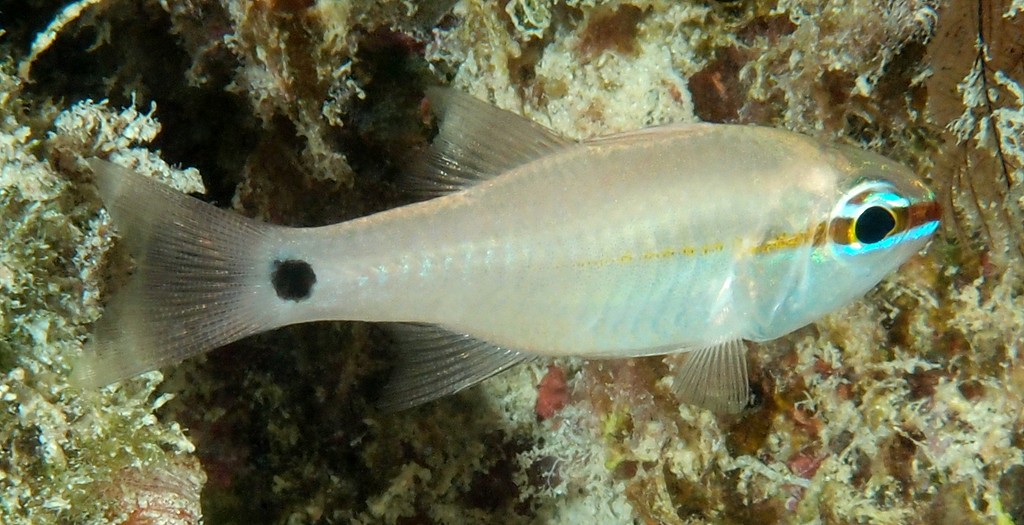OSTORHINCHUS CAPRICORNIS - (ALLEN & RANDALL, 1993)
Actinopterygii (Gigaclass) > Actinopteri (Class) > Teleostei (Subclass) > Gobiiformes (Order) > Apogonoidei (Suborder) > Apogonidae (Family) > Apogoninae (Subfamily) > Ostorhinchus (Genus)
Capricorn cardinalfish, 羊角天竺鯛,
Synonyme
Apogon capricornis (Allen & Randall, 1993)
--------------------------
Description
Dorsal spines (total): 8; Dorsal soft rays (total): 8-9 (usually: 9); Anal spines: 2; Anal soft rays: 9; Pectoral fin rays: 14; Pelvic-fin rays: I, 5; Lateral line scales: 24; Median predorsal scales: 4; Gill rakers: 5-7 + 17-18 = 22-24; Preopercular margin serrate; Preopercular ridge smooth, weakly crenate, or with tiny serrae around angle. Body depth: 2.9-3.3 in SL. Max. length: 10.0 cm TL. Depth range: 2 - 90 m, usually: 10 - 30 m.
Color
Dusky yellow grading to brassy or golden yellow below, with a black spot (slightly smaller in size than pupil) centred on the caudal peduncle, and pair of bright blue stripes running through the eye (lower stripe extending to the rear of the gill cover).
Etymology
Ostorhinchus: from Greek, osteon = bone + from Greek, rhynchos = beak. In reference to the bony jaws, very much advanced and jagged, which take the place of the teeth.
capricornis: the specific name is from the Latin in reference to the distribution of the species.
Orignal description: Apogon capricornis Allen & Randall, 1993 - Type locality: Outer reef on northern side of One Tree Island, Capricorn Group, Great Barrier Reef, Australia.
Distribution
Southwestern Pacific: southern Queensland to northern New South Wales (Australia) and New Caledonia.
Biology
Usually shelters in caves and crevices during the day. Usually active at night, and individuals or small groups emerge at dusk to feed on benthic invertebrates and zooplankton. Mouthbrooders. Distinct pairing during courtship and spawning.
Similar species
Ostorhinchus apogonoides (Bleeker, 1856) - Reported from New Caledonia - Link to the species (here).
Ostorhinchus cladophilos (Allen & Randall, 2002) - Reported from New Caledonia - Link to the species (here).
Ostorhinchus diversus (Smith & Radcliffe, 1912) - Reported from Western Pacific.
Ostorhinchus flavus (Allen & Randall, 1993) - Reported from New Caledonia - Link to the species (here). Differs in having a pair of white stripes running through the eye, versus neon blue stripes in Ostorhinchus capricornis.
Last update: 27, September 2022
Synonyme
Apogon capricornis (Allen & Randall, 1993)
--------------------------
Description
Dorsal spines (total): 8; Dorsal soft rays (total): 8-9 (usually: 9); Anal spines: 2; Anal soft rays: 9; Pectoral fin rays: 14; Pelvic-fin rays: I, 5; Lateral line scales: 24; Median predorsal scales: 4; Gill rakers: 5-7 + 17-18 = 22-24; Preopercular margin serrate; Preopercular ridge smooth, weakly crenate, or with tiny serrae around angle. Body depth: 2.9-3.3 in SL. Max. length: 10.0 cm TL. Depth range: 2 - 90 m, usually: 10 - 30 m.
Color
Dusky yellow grading to brassy or golden yellow below, with a black spot (slightly smaller in size than pupil) centred on the caudal peduncle, and pair of bright blue stripes running through the eye (lower stripe extending to the rear of the gill cover).
Etymology
Ostorhinchus: from Greek, osteon = bone + from Greek, rhynchos = beak. In reference to the bony jaws, very much advanced and jagged, which take the place of the teeth.
capricornis: the specific name is from the Latin in reference to the distribution of the species.
Orignal description: Apogon capricornis Allen & Randall, 1993 - Type locality: Outer reef on northern side of One Tree Island, Capricorn Group, Great Barrier Reef, Australia.
Distribution
Southwestern Pacific: southern Queensland to northern New South Wales (Australia) and New Caledonia.
Biology
Usually shelters in caves and crevices during the day. Usually active at night, and individuals or small groups emerge at dusk to feed on benthic invertebrates and zooplankton. Mouthbrooders. Distinct pairing during courtship and spawning.
Similar species
Ostorhinchus apogonoides (Bleeker, 1856) - Reported from New Caledonia - Link to the species (here).
Ostorhinchus cladophilos (Allen & Randall, 2002) - Reported from New Caledonia - Link to the species (here).
Ostorhinchus diversus (Smith & Radcliffe, 1912) - Reported from Western Pacific.
Ostorhinchus flavus (Allen & Randall, 1993) - Reported from New Caledonia - Link to the species (here). Differs in having a pair of white stripes running through the eye, versus neon blue stripes in Ostorhinchus capricornis.
Last update: 27, September 2022
